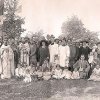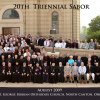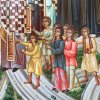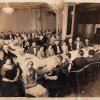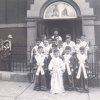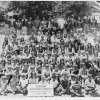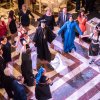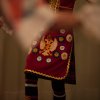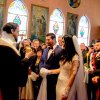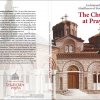By Milina Jovanović
Background
This paper examines various social roles that the Serbian Orthodox Church has assumed in supporting Serbian immigrants in the U. S. Almost “organically” the Church became one of the few Serbian institutions that started helping immigrants early on to navigate the U. S. society and to preserve their ethnic and cultural identity. When I conducted research between 2003 and 2007, in Jackson, California, home of the exceptional Serbian community and the birthplace of the first Serbian church on this continent, many individuals talked about several important roles the church had played in their lives. In reviewing the existing literature, I found sources that addressed the same topic, highlighting different aspects. Other researchers also interviewed Jackson residents of Serbian descent, and their respondents also mentioned how the church had played numerous roles throughout the 150-year long history of that region. Additionally, between 2004 and 2006, I conducted a survey with Serbian Americans who did not live in Jackson but nevertheless maintained strong ties with Amador County. That survey was distributed to sixty-five individuals and twenty-seven returned their questionnaires at that time. Most of them wrote about what the Jackson’s St. Sava Church meant to them and how it had played an important role in their efforts to preserve or strengthen their Serbian American identity. Subsequently, after publishing my first book All Roads Lead to Jackson, l continued my research and discovered the work of Krinka Vidakovic Petrov. Her book about Serbian Americans was already published in Belgrade. A few years later I translated Serbian Americans: History, Culture, Press making it available in English. Vidakovic Petrov’s research was wide-ranging and encompassed Serbian American history, art, culture, and publishing activities that had occurred in all major immigration centers in the U. S. from the time the first immigrants organized themselves into communities to the beginning of World War II. Many people who attended my book events made me realize that further research was needed, especially on the more recent history of the Serbian Orthodox Church, in order to shed more light on its social influence among Serbian communities in the U. S. For that reason, I conducted another survey between December 2016 and April 2017 to assess this impact and capture how respondents from the largest Serbian communities, geographically dispersed throughout the country, view social roles of the Church.Methodology
The questionnaire I distributed among volunteers from the major immigration centers had six questions and most of them were open-ended because I was interested in hearing their descriptive answers. Furthermore, I intended to capture respondents’ voices, as much as it is possible by utilizing predominantly quantitative methodology. Some respondents only vaguely addressed the questions and wrote their opinions or stories instead. I welcomed such responses although this made my data analysis more complex and challenging. In this article, l included quotes from these surveys, my previous research, and other materials, as often as I found appropriate. The questionnaire was bilingual in English and Serbian. Most respondents wrote in English, but 20% of them replied in Serbian.
The following cities, states, and regions were represented in my newest survey conducted at the end of 2016 and first half of 2017: Northern California including Amador, San Francisco, Santa Clara, San Benito and Yuba Counties; Southern California including Los Angeles and Orange Counties; Phoenix, Arizona; Galveston, Texas; Columbus, Ohio; Detroit, Michigan; greater Chicago area, Illinois; Pittsburgh, Pennsylvania; Butte, Montana; Miami, Florida; Washington DC, and New York, New York. As l included major immigration centers on both coasts, the mid-West, and the South, my hope was that these regions would constitute a nearly representative sample of regions and groups. Hundreds of surveys were sent electronically to different lists and directly to individuals. Thirty-six of them sent their questionnaires back and their voices are included in this article. I also used interview material and other documents I collected during my previous research projects, as well as those published by Milan and Helen Karlo[1], Luka Pejovic[2], Bishop Sava Šumadijski[3] and Krinka Vidakovic Petrov[4]. Serb World USA[5] also has a collection of Serbian American stories containing discussions or opinions that highlight the importance of Serbian Orthodox religion and social roles that their parishes have played in the lives of many communities and individuals. The entire material I collected and additional sources are synthesized in this article. Additionally, l added some reference to surveys and interviews I conducted between 2003 and 2007. My earlier project focused on participants in Amador County, California.Summarized History of Serbian Immigration Interwoven with Serbian Orthodox Church
When the Serbian Orthodox Church was established in the U. S., one of its primary goals was to make the first Serbian immigrants’ lives better. It should be noted that the very first social organizations created by Serbian immigrants in the U. S. were also influenced by their religious traditions and some were named after Serbian saints. Even though it wasn't an easy task to establish the Serbian Orthodox Church on this continent, early Serbian immigrants knew the importance of perseverance. They experienced firsthand how their cultural, linguistic, and spiritual needs were all intertwined and intuitively knew that their first church would be much more than a place of worship. Indeed, St. Sava of Jackson, California, the very first Serbian Orthodox Church on the North American continent, was established on claimed land and became a symbolic home in their new country. Jackson’s St. Sava was at the same time an oasis, a sacred space, and a center of their lives in 1894. Since then, much has changed, but the church has continued to play multiple roles and to have special importance in the hearts and minds of Serbian immigrants. In addition to satisfying their religious and spiritual needs, many social, linguistic, and cultural needs have also been addressed, including the preservation of individual, group, and national heritage. Most of the early Serbian immigrants worked in the mines and performed other difficult, low paying jobs. They were often exhausted, but they had a strong will to preserve their cultural identity and to find a way to satisfy their spiritual needs. As noted by Bishop Sava Šumadijski, the first Serbian immigrants did not like the U. S. and the U. S. didn't care much for them either.[6] Serbian people immigrated in several waves. Most scholars agree that the first period of Serbian immigration was roughly from 1820 to 1880. During this time, the most numerous were immigrants from the Bay of Kotor and Herzegovina, but some also came from Serbia. The next wave came between 1880 and 1914—the time of intense industrialization in the U.S. Understandably, a wave of people also came between the two World Wars and during World War II. After 1945, or during the 1950s and early 1960s, many immigrants came to the U. S. for political reasons as they disagreed with the Yugoslav government. This group of people, along with students, business people, scientists, and others continued to immigrate in smaller numbers until the 1990s. The final large wave of immigration was observed during the late 1990s and early 2000s, the period of Yugoslavia’s dismantling. They came to the U. S. as victims of war and “refugees of the global economy.” This wave has continued until current times, mainly caused by the current state of Serbian socio-economic and political realities.In general, the main reasons for Serbian immigration to the U.S. have always been multiple, but predominately economic. In the most recent decades, Serbian populations were either not eligible for the refugee status, or received it less often than other groups, even if they originally escaped from Bosnia.
After the Civil War, the U.S. experienced dramatic industrialization and a great need for labor power, so it opened its doors to European immigration with almost no limits. The number of immigrants strikingly increased and culminated in 1907. New mines (coal, iron, copper) and factories (locomotives, wagons, cars) were opened and new mining and manufacturing towns mushroomed. Many of those towns were filled or inhabited with Serbian immigrants. This is the time when most Serbian communities were established in the U. S.
The first benevolent societies created by Serbian immigrants played many important roles. They preceded church-school congregations that also mushroomed in the early 1900s. Some Serbs had more influence in their church-school congregations than others because they paid for regular membership, and others approached these congregations only if they needed something.[7] The most important role of those church-school congregations was to collect funds to build churches across the country.
Between 1900 and 1918, twenty-nine new Serbian churches were established. A few Serbian churches, such as St. Sava of Jackson, CA had been already established by the early 1900s. Among the churches that were established in the early 1900s were those in Pennsylvania, Douglas (Alaska), Chicago (Illinois), Butte (Montana), and St. Louis (Missouri). From the very beginning, there was an issue of canonical jurisdiction over the Serbian Orthodox Church in America. Before this issue could be resolved in a proper way, the only viable solution seemed to accept the temporary jurisdiction of the Russian Church in America. This question was finally resolved when the Serbian Orthodox Church based in Belgrade founded the American-Canadian Diocese in 1921 and appointed its first bishop in 1926.
There has been an integral connection and symbiotic relationship between the Serbian Orthodox Church and various Serbian schools in the U. S. This has been true since the early 1900s when the first church-school congregations were created. Even today, it would be challenging to find examples of Serbian schools that have existed independently. The first teachers in such schools were priests, but later individual women and women’s organizations assumed the educators’ role. During the early days of Serbian immigration there was an independent library in San Francisco associated with the Serbian-Montenegrin Literary and Benevolent Society. This library was called a reading room and it was created in 1879[8]. In 1906, a Serbian school was also created in San Francisco, independent from any church and associated with the same Serbian-Montenegrin Literary and Benevolent Society[9]. Other educational institutions have almost exclusively been attached to churches, with various levels of religious instruction incorporated into the school curriculum.Another organization that historically played a significant role in the lives of Serbian immigrants was The Serb National Federation. This Federation has had a very important connection with the Serbian Orthodox Church since its inception. The leadership of the Federation has also had its own dilemmas whether and how much to distance themselves from the church. However, over time they have maintained connections and collectively they have addressed many critical needs of Serbian immigrants and their families.
When churches were built they became centers of religious, social, cultural, linguistic, publishing, educational, and artistic life of Serbian immigrants. We collected enough evidence to conclude that the Serbian Orthodox Church continues to play these roles even today.
Bringing Together Serbian Immigrants: Connecting and Unifying Role of the Serbian Orthodox Church
Serbian immigrants live in the U. S. dispersed across the vast space, and it has always been challenging to connect them. This was especially the case in the late 1800s and early 1900s. However, the Serbian Orthodox Church was one of the few organizations that tried to unify the community and help them communicate despite the many geographical barriers. Their individual churches, and the Serbian Orthodox Church as an institution, has provided resources, common platforms for communication, organized regional and national gatherings, celebrations and festivities. Many Serbian immigrants talk about this kind of support and common space that the Church has provided for them even today.
As Krinka Vidakovic Petrov documented extensively, four types of Serbian organizations basically had the same goal of supporting immigrants to preserve their cultural and ethnic identities. These are: churches, benevolent societies, cultural clubs, and ethnic media.[10] In many instances, clubs, libraries, and publishing companies have been attached to churches or dioceses. New immigrants have always needed more support, orientation, and education about the U. S. society than the rest of the community. For them, churches often serve as an introduction to both: already established Serbian institutions and the larger receiving community of Americans.
Serbian immigrants organized cultural, religious, and ethnic associations to provide support to one another and to structure their everyday lives as a community. In those early days, they usually lived close to one another in the same urban areas and organized the same way they did in “the old country,” where villagers formed zadrugas (something resembling an extended family cooperative). Once they arrived in the U. S. they couldn’t form the same associations or family based collectives as most were young, single men. However, they usually assembled according to their common regional origin, as cousins or neighbors from the same village. At first, they lived in boarding houses owned by their fellow countrymen who immigrated earlier. These owners of boarding houses usually had wives who provided multiple services including cooking and laundry in exchange for an additional fee. In some cases, women were boarding house owners because they lost their husbands in mining and other accidents. As documented by Krinka Vidakovic Petrov and in numerous interviews, the boarders had room and board, but spent most of their time working or sleeping. One of the women that I interviewed in 2005, the late Ann Ingram, also talked about the boarding houses that existed during her childhood in Jackson, California. She highlighted the difficult life of the miners and called them contemporary slaves[11]. However, when they had some free time, they also socialized with others who were staying in the same boarding houses. Social and cultural integration into the larger society was a very slow process. Serbian immigrants felt the need to establish their own ethnic organizations first, then formed benevolent and cultural associations. These organizations provided basic health and life insurance on the job for surviving family members. Working conditions were very dangerous and accidents occurred daily, especially in the mines and steel mills where workers often suffered serious injuries or loss of life. Krinka Vidakovic Petrov observed four important reasons for high levels of alienation among early Serbian immigrants: 1) dangerous and difficult/exhausting work with long working hours, 2) social transition from peasants to proletarians and industrial workers, 3) sharp differences between the original culture of Serbian immigrants and American cultural norms, and 4) social isolation and resistance in the process of acculturation.[12]To address alienation and prevent appearance of additional sources of oppression, something had to be done. During those times, benevolent societies were the most important organizations that helped Serbian immigrants to survive and address their multiple challenges. When the numbers of benevolent societies grew substantially they needed to organize as federations. Subsequently, these federations became financially powerful and assumed additional political and cultural roles. Clubs, youth, and sports organizations, as well as choirs, and other societies were also formed quite early to address social and cultural needs of Serbian immigrants. Most of those organizations were modeled on similar institutions that existed in their homeland.[13]
During war times, Serbian immigrants had primarily focused on their homeland and volunteered to join war efforts or raise funds. But when there was peace they turned their attention to integration into the American society, while at the same time aiming to preserve their ethnic, cultural, and linguistic roots and ties with the homeland.
The question of Serbian immigrants’ religious needs became important early on, and especially during the Gold Rush times. Immigrants addressed the church authorities in Serbia asking for priests, but they couldn’t be sent for a long time. When immigrants established their church-school congregations, they had to finance building of their own churches and provide for the priest. At that time, the only Serbian priest born in the U. S. was Sebastian Dabović, whose family was already established in San Francisco.
The first Serbian church on the American continent was built in 1894, in Jackson, California by Serbian miners and their families. St. Sava Church meant so much to them in the 1890s. This small, elegant structure has always meant much more than a place of religious worship; it was perceived as a “piece of home.” Today, it is also a material reminder of a vibrant community that has existed there. During the Gold Rush times that small church building meant everything to the miners. The community that built the church with their own efforts, on a minimum-wage salary, was proud but struggling. Yet, building the first church on the North American continent provided inspiration and hope. Many community members thought that it was worth working day and night, and even dying young, if new generations had hope for a better future. They were devoted and ready to do the extra hard work. This type of work was also dangerous and many lives ended prematurely.
Since the building of the first Serbian Church, and especially since the 1920s, in addition to fulfilling their important religious roles, churches have served as gathering places, one-stop resource centers, sources of national or ethnic empowerment, and bridges between the homeland and the U. S. Most recently, the organization and reorganization into different dioceses has contributed to the role of internal-administrative unity and strength.[14] With the development of printed media, many regional issues became known much wider and information sharing became more frequent. Priests and other religious leaders also had their own newsletters and the ambition to inform and unify the larger community. Together with Narodna Odbrana (National Defense), they have played a role in various humanitarian efforts and somewhat in facilitating the recruitment of volunteers during major wars. The establishment of the Dioceses also signified an important unifying role, easier communication, and new ways to address the common needs of Serbian immigrants. Beyond the obvious religious and spiritual unifying power, the Serbian Orthodox Church has remained an important factor in providing avenues for the newly arrived and long-term residents alike to find their own purpose, develop a new Serbian American identity, and renew their sense of belonging in a completely different world. While, naturally, the Church has its own religious mission as a priority[15], the development and preservation of a unique Serbian American ethnic identity is in everyone’s common interest.In Their Own Words: Serbian Americans Value the Connecting Power of the Serbian Orthodox Church
Serbian Americans still see the Serbian Orthodox Church as an institution that’s playing a very important role in their lives. This is true for all immigrants, even those whose primary connections to their parishes are not religious.
Many talked about how the church has helped them to connect with other Serbian Americans, navigate different systems, find much needed resources, hear the news from the homeland, and understand multiple issues they face in the U. S., as an ethnic group. Here is how they described their reliance on their parishes, in their own words:
“I feel connected with my parish… also to my friends, and Serbian culture… Nostalgia plays an important role when I go there. I can rarely visit my homeland, so my parish is the next best thing.”
“Everything links me to my parish: my religion, clergy, other members, culture, iconographic, the St. Sava and St. Mardarije tradition.”
“We are members of the church-school community near Seattle, WA. This community means a lot to us—it has saved us, it helps us to preserve our traditions, cultural heritage and Serbian language. To all of us whose real families live far away, the church-school community IS our family.”
“I live in both Serbia and in Pennsylvania. Balancing between the two countries and always being in transition, the church and my faith have been the two stable pillars, in the sea of changing realities.”
“Our church gives me a sense of belonging… it really connects people who live far away from their homeland.”
“My church is my life.”
“Our church provides us a firm foothold and gives real depth to our spiritual life.”
“My parish church is a sanctuary—probably the one place in the world where I feel most at peace and quite safe.”
“I made lifelong friends through my New York parish and now belong to a wonderful community of people in Saratoga. This church has a special place in my heart as I didn’t know many people when I moved to California.”
“I lived in several states and all of those churches I attended helped me to get to know people, participate in services and cultural events. We also had a chance to introduce non-Serbs to Serbian culture, food and music.”
“I cannot imagine my life without our Serbian Orthodox Church. I know I am at an age when the church will still be here for me. I am just worried about younger generations. They have no time.”
“Our little church in Galveston has survived many hurricanes and has served as an evacuation center/accepted refugees during the 1900 and 1915 hurricanes.”
“My church is a place where I can always find any kind of support needed.”
“For many decades, the Church has been a glue that has held the Serbian-American community together.”
Of all 2017 survey respondents, 90% said that the Serbian Church had important unifying and connecting functions. They talked how they congregate towards their respective church communities to find gathering places, resources, and guidance to navigate various sets of systems in the U. S., find friends and likeminded individuals. Many of these respondents also emphasized that the Serbian Orthodox Church has always had this important role and aimed to bring Serbian immigrants together so they can preserve and redefine their ethnic identities, stay connected with their homeland, or engage in direct action, such as volunteer in their communities, or organize humanitarian activities. Some even mentioned that their parishes had an important role in informing them and helping organize polling places so they could vote in Serbian elections. This has been a very recent phenomenon. Others emphasized that the Serbian Church in America has assumed a leadership role since its inception. The following quote shared by one respondent represents those ideas very well: “The Church has been a great leader that paves the way so our people can preserve our religious, national, social, linguistic, and cultural identity.” When it comes to the leadership role, some respondents specifically underscored the role that the Serbian Orthodox Church had played during major wars affecting Yugoslav territories and the support it provided through information sharing, publishing, bringing artists and public intellectuals to speak about various important topics. This has been very important in shaping the development of Serbian national identity in the diaspora. The respondents who shared such ideas about the Church’s unifying and leadership role were more familiar with the church history, and in some instances, they were social scientists.Serbian Orthodox Church as a Sacred Sanctuary Space
Additionally, the people I interviewed also see the church as a symbolic institution that provides them with support extending beyond religious and/or practical importance. While they think about their churches as symbols of their own Serbian land in the U. S. (like embassies), in some cases they also see their parishes as magnets that draw them to the center of social, educational, cultural and artistic activity.
As already mentioned above, many Serbian Americans think of their parishes as sanctuaries in both religious and broader spiritual meaning. It became clear that for most respondents their churches represent sacred spaces in the broadest sense. In some instances, even atheists see it in that light. These churches are so symbolic, seen as a “piece of homeland,” oases where they can meet other people of similar backgrounds, speak their native language, hear Serbian music, dance kolo, and if they have children, ensure that their children have a chance to attend Serbian Orthodox religious instruction, learn about their national history, culture, and Serbian language. It should be emphasized that 97% of all respondents pointed out that the Serbian Orthodox Church in America had played a major positive role in their lives and the lives of other immigrants.Asked what the Serbian Church exemplified for them personally, respondents shared an array of symbolic expressions. One said: “It represents light in the darkness of today’s world.”
“I see our Church as an extension of Christ’s Body, place where we are unified with God, where we can find salvation. Additionally, I see our church community as my extended family, communion where our children can learn Serbian culture, language, music and traditions,” said another.
“For me, the Church exemplifies a mechanism for survival and unity.”
“Church exemplifies a sanctuary for me. It is the place where I have developed understanding of my relationship with God. It also symbolizes the fruits of faith.“
“Church is a symbol of our sacred existence on this continent.”
“Church provides roots to our community and welcomes newcomers.”
“It’s a beacon of light that guides me through difficult times.”
Some even said that their churches meant “everything to them.” Evo Vasilovich, George Brayovich, Ann Ingram, and Sam Kostich used similar terminologies to describe their attachment to Jackson’s St. Sava Church when I interviewed them in mid-2000s. Helen Jaich also talked how everything in her life revolved around the church and how she waited eagerly for each Sunday to drive to Jackson. Her passion and volunteer work also influenced her son Milan who became very involved in the continuous operation and preservation of the St. Vasilije of Ostrog Church in Angels Camp, California. Being such a unique tightly knit community for more than 150 years, almost everyone who lives in Jackson sees the little historic St. Sava Church as an epicenter of their lives. It has been that way for generations and some of these findings, resident thoughts, and ideas have been reflected in my book All Roads Lead to Jackson.[16]
Serbian Church as an Important Center of Social and Cultural Life
Even Church officials recognize that specific parish churches, and the Serbian Orthodox Church as a whole, continue to mean a lot to Serbian Americans. Beyond being places of worship, they have often provided gathering spaces, connected people and remained important centers of social, cultural and artistic life. It seems that an overarching agreement has existed, recognizing that religious and social functions of the Church are not mutually exclusive. While officials might disagree on the question of this balance of different roles and how much to focus on social and cultural needs of immigrants in recent times when many other organizations might exist in specific communities, most of them participate in social functions and acknowledge that these multiple roles reflect the importance that the Church has had in the lives of Serbian immigrants on multiple fronts[17].
This was also the main finding in the most recent research project that I conducted. All but two respondents to my 2016-7 survey emphasized social and cultural functions that the Church has assumed. The following quotes represent a sample of their responses:
“While it might seem that our Serbian culture and spirituality are currently not under attack, it is easy to lose those things when living in a foreign country.”
“Church provides space where I can find friends and community, instead of feeling lonely. I am not religious, but it means a lot to me to speak my native language, meet our people, eat Serbian food, hear Serbian music. When I go to our church, all of that becomes possible.”
“Sometimes I attend celebrations, different cultural and artistic events. When I go to my parish church, I get information about our homeland and feel connected to my roots.”
“I met several close friends for the first time in our church.”
“My family and I participate in several clubs and my children have a lot of fun with their friends.”
“I found a beautiful new community.”
“Through the church I get information about our history, culture, news from the homeland, learn how to vote in Serbian elections… I also enjoy sport events and professional clubs.”
“Our parish provided me with opportunities to serve on boards and participate in a Mother’s Club, young tamburitza players, church choir, and I help organize Serbian food festivals. One of my grandmothers was a long-term member of the Kolo Srpskih Sestara (KSS) organization.” “Svetosavlje is a lifestyle—living as an Orthodox person who embodies Serbian cultural aspects sanctified and blessed through connections with our faith.”
“In addition to salvation, Serbian Orthodox Church has a unifying goal. It also assumes cultural roles of gathering people together, preserving religious and cultural traditions. Serbian language is somewhat preserved in this process as well. More recently, I’ve observed a limited missionary role of our church and I am very glad when salvation is offered to everyone.”
“I am involved in our church school and happy that we have increased numbers of students every year. Children learn language fast and they learn about our cultural heritage. Parents also get connected and engaged, so everyone benefits.”
“I have seen a number of concerts, events, and theatre plays. Being exposed to Serbian arts and culture is very important to me, but I would like to see more artists come from Serbia to perform here.”
“I think church plays the most important role as a resource for newcomers. I’ve seen several families ask for help and support and our parish priest has done the work of connecting them with right people and resources. I also like that our priest and board members send updates and newsletters, so we can read not only the scriptures, but also learn about events and community news.”
This sample illustrates the most common responses about the social and cultural functions that the Serbian Orthodox Church has undertaken, being often the only major Serbian organization available. Regardless of their background and worldviews, Serbian immigrants recognize this important role and see the Church as a “glue,” “gathering places where they can meet friends,” “cultural and artistic centers,” “church-school congregations where children learn Serbian language, history and culture,” and as a “resource center.” Since the early times, church communities have participated in events and hosted Serbian art troupes, musicians, singers, painters, writers, scholars and other creative people. Therefore, their important cultural roles remain preserved.
Conclusion: Social, Cultural, Educational, and Unifying Roles of the Church are Recognized and Valued
Since its inception, the Serbian Church in America has had different and more complex functions than the Church in the motherland. The first Serbian immigrants were on their own, far away from home and practically unable to acculturate during the first few waves of immigration. Only a few other Serbian organizations, such as benevolent societies existed in the mid and late 19th Century. Additionally, Serbia was not able to send priests or funding, so Serbian immigrants had to save and invest their own money in building churches, while working the most dangerous jobs and receiving minimum wages. Their needs were multiple and they wanted their churches to help address many of those needs, not only spiritual and religious. Over time, other groups, clubs, and organizations were formed. However, even nowadays, most of the ethnic, professional, and cultural organizations are either integral parts church-school communities or closely working with them. Serbian immigrants have seen their parishes and the Serbian Orthodox Church in America as sacred places, sanctuaries, resource centers, extensions of their Serbian families and an extension of their homeland. While some of the survey respondents noted that the Serbian language was not preserved on the level they expected, Serbian churches still play a role in the linguistic and cultural preservation.The 2017 survey has confirmed that Serbian immigrants see their churches and communities as crucial in the cultivation and preservation of their ethnic, cultural, artistic, and linguistic hybrid identity. It is striking that more than 95% of the survey respondents associated everything positive with the Serbian Orthodox Church in America and saw its multiple social roles as “natural and needed.” Sociologists will likely have a pronounced interest in researching levels of alienation and loneliness in the contemporary Serbian American communities. They might even compare those who found connection in their congregations to those who have no such connections. In addition to religious, most of the survey respondents talked about satisfying their own social, educational, and cultural needs in their parishes. Similarly, the great majority of respondents saw that the Church has successfully played a unifying role and only a few respondents even mentioned some past divisions affecting the Church administration and the broader Serbian community. Almost everyone who responded to my questions saw the Serbian Church in America as an institution that is stable, consistent, and persistent in its efforts to unify and support the whole community.
The Church has been also seen as a bridge between the homeland and the new world in the U. S., and a symbol of our continual presence on this continent since the early 1800s. While there are no government sponsored and hardly any private Serbian American schools, church-school congregations have been perceived as the most important educators of future generations, in hope that Serbian Americans will continue to learn the basics of their own history, language and culture. Youth camps also, such as the one organized in Jackson, California play a significant role in these efforts. They typically combine religious and non-religious instruction and activities. Many Serbian Americans are not bilingual anymore, but most of those that I have talked to would like to at least achieve basic fluency in Serbian.
A new research study might be conducted to examine this division between religious, social, educational, and cultural roles of the Church in a greater depth. Such a study could also include the clergy to compare their perceptions to those of their parishioners and community at large. While similar studies are needed, we already have enough evidence to conclude that the Serbian Orthodox Church in America has had critical connecting and unifying roles. As an institution it has provided stability, spiritual, and practical guidance to Serbian immigrants to preserve their ethnic and cultural identity.
-------
[1] Karlo, Milan and Helen. 1984. Early Days: Serbian Settlers in America. Tucson, AZ: self-published.
[2] Pejovic, Luka. 1934. Srbi u St. Luis-u. San Francisco: R & E Research Associates.
Pejovic, Luka. 1935. Jugosloveni na jugu: Louisiana-Texas-Mississippi. San Francisco: R & E Research Associates.
Pejovic, Luka. 1936. Srbi na srednjem zapadu: Michigan. San Francisco: R & E Research Associates., pp. 33-6
[3] Bishop Sava Šumadijski. 1994 (reprinted). Istorija Srpske Pravoslavne Crkve u Americi i Kanadi 1891-1941. Kragujevac: Kalenic. p. 10
[4] Vidakovic Petrov, Krinka. 2015. Serbian Americans: History, Culture, Press. Alhambra, CA: Sebastian Press. p.
[5] Example: Niklanovic Hart, Mary. 2005. St. Nicholas Parish 1905-2005. Serb World USA, no. 6, pp. 52-3
[6] Bishop Sava Šumadijski, Ibid, p. 22
[7] Vidakovic Petrov, Krinka. Serbian Americans, Ibid. p. 49
[8] Vidakovic Petrov, Krinka. Serbian Americans, Ibid. p. 98
[9] Ibid, p. 99
[10] Ibid, p. 49
[11] Jovanovic, Milina. 2013. All Roads Lead to Jackson: Serbian American Contributions in Amador County, CA since the Gold Rush. Alhambra, CA: Sebastian Press. p. 60
[12] Vidakovic Petrov, Krinka. 2014. Od Balkana do Tihog Okeana. (From the Balkans to the Pacific Ocean). Beograd: Institut za Kulturu i Umetnost, p. 48
[13] Ibid, p. 62
[14] The History of the Serbian Western American Diocese. 2013. pp. 22-23
[15] Ibid., p. 23
[16] Jovanovic, Milina. 2013. All Roads Lead to Jackson: Serbian American Contributions in Amador County, CA Since the Gold Rush. Alhambra, CA: Sebastian Press.
[17] The History of the Serbian Western American Diocese, Ibid., p. 23

